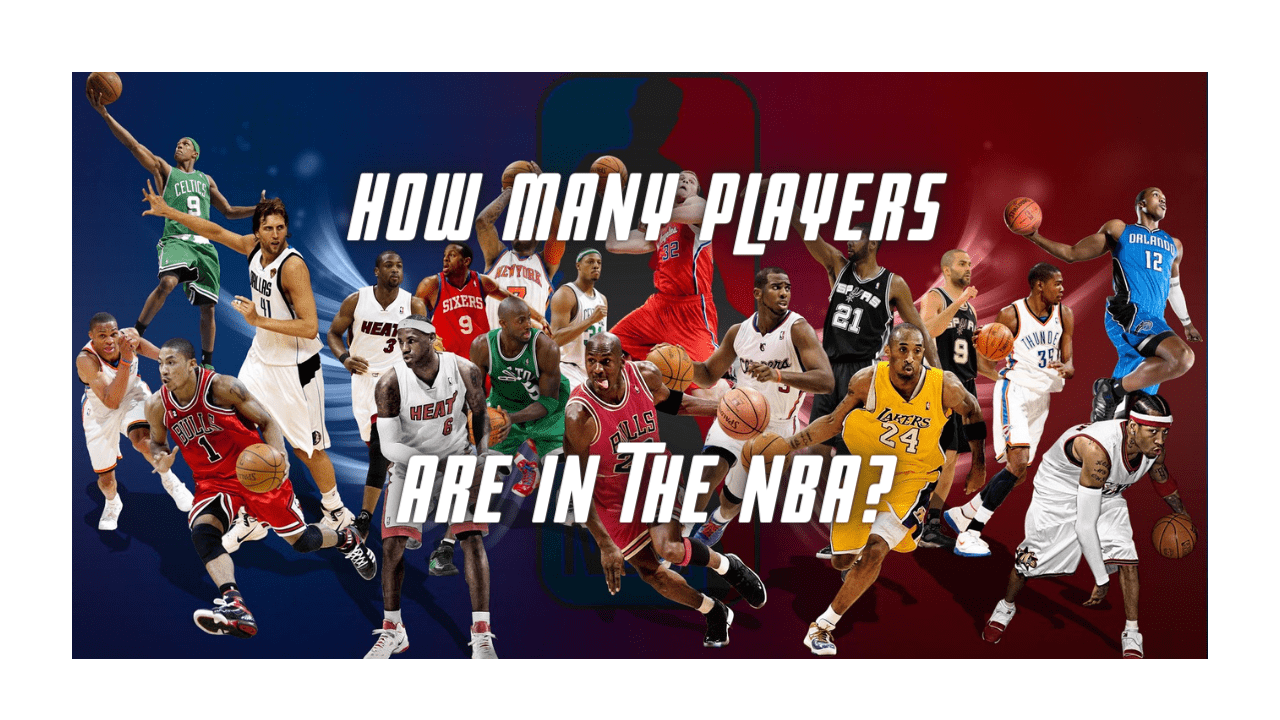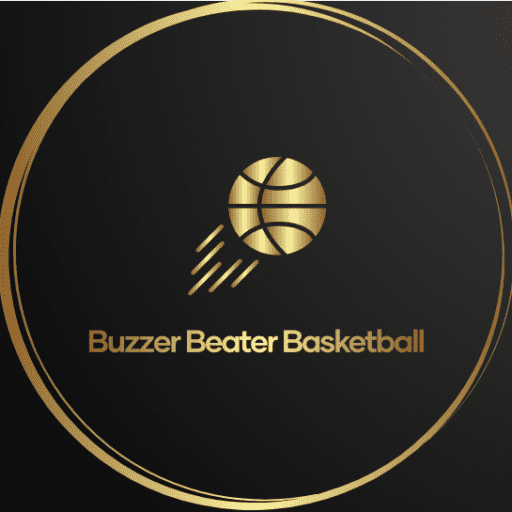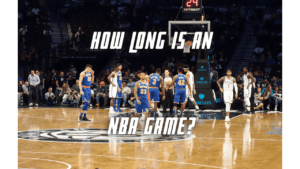How Many Players Are There In The NBA?

You have obviously come here because you want to know how many NBA players there are playing in the league. There are 30 teams in the league and each team has 15 roster spots that they can fill so this means at any one time the NBA can only have a maximum of 450 active players. However not every team will have all 15 roster spots filled at all times so the number of players active in the league can fluctuate for many reasons as follows:
- Trades
- 10 day contracts expiring
- G League call ups
- Players getting waived mid season
- Two Way Contracts
- Injuries
- Retirements
It is therefore possibly that in a single NBA season there could and likely will be more than 450 players that have played in any one season, there however will not be more than 450 on any given day.
How Many Players Are On An NBA Roster?
How many players are on an NBA Team? Traditionally, an NBA team boasts a roster of 15 players, each handpicked for their unique blend of talent, skill, and grit. Yet, within this framework lies a delicate balance – a ballet of numbers and positions choreographed to perfection. At the forefront stand the starters, the maestros of the court, whose virtuosity ignites the spark of competition. These players are usually but not always the 5 most talented players. But beyond the limelight dwell the bench players and reserves, the unsung heroes who await their cue to take center stage. Their role is no less crucial, providing depth and resilience to weather the ebbs and flows of the game. These players give the starters much needed rest and usually have specific roles.
Maximum Number Of Active Players Per Game
Navigating the intricacies of active player numbers within the NBA’s regulatory framework is essential for teams aiming to maintain competitive edge and compliance. These regulations are designed to ensure fairness and parity across all franchises, shaping the dynamics of roster management throughout the regular season.The NBA imposes strict guidelines on the number of active players permitted during regular season play. Teams are typically allowed to have up to 15 players on their roster, each carefully selected for their unique blend of talent and skill. However, only a subset of these players can be designated as active for any given game.Central to these regulations is the maximum number of active players permitted per game. This limit, typically set at 13 players, serves as a pivotal factor in team strategy and lineup decisions. Coaches must carefully weigh factors such as player availability, matchups, and injury status when determining which players to activate for each game.
In addition to setting limits on active players per game, the NBA also provides guidelines for roster management throughout the season. Teams must navigate a myriad of challenges, including injuries, roster fluctuations, and strategic acquisitions, while adhering to league regulations.To address roster needs and adapt to changing dynamics, teams may utilize call-ups and signings from their G League affiliates or free agent pool. These roster adjustments play a crucial role in maintaining team depth and flexibility over the course of the season.
How Are NBA Rosters Managed?
One of the primary considerations in NBA roster management is player health and availability. Injuries are an unfortunate reality of the game, and teams must develop strategies to mitigate their impact on roster composition. This may involve implementing rigorous training regimens, investing in cutting-edge sports medicine facilities, and closely monitoring player workload to minimize the risk of injury. Another key aspect of roster management is maximizing player availability. This requires teams to carefully manage player minutes and rotations to ensure that their key contributors remain fresh and healthy throughout the grueling NBA season. Coaches must strike a delicate balance between pushing players to their limits and avoiding overexertion, especially during back-to-back games and extended road trips.
Adapting to evolving roster dynamics is also a critical component of NBA roster management. Throughout the season, teams may encounter a variety of roster challenges, including trades, injuries, and player signings. To navigate these challenges successfully, teams must remain agile and flexible, adjusting their roster compositions and lineup strategies as needed to maintain competitiveness. In recent years, advancements in analytics and player tracking technology have revolutionized NBA roster management. Teams now have access to a wealth of data and insights that enable them to make more informed decisions about player performance, injury risk, and lineup optimization. By leveraging these tools effectively, teams can gain a competitive edge and maximize their chances of success on the court.
G-League Call-Ups and Signings: Adapting to Roster Dynamics
Call-ups and signings involve promoting players from the G League, the NBA’s official minor league, or signing free agents from the pool of available players. These roster adjustments are typically made in response to injuries, roster vacancies, or specific matchup needs and can have a significant impact on a team’s performance and success.
One of the primary benefits of call-ups and signings is their ability to provide immediate reinforcement to a team’s roster. When a key player goes down with an injury or is unavailable due to other reasons, teams can turn to their G League affiliates or the free agent market to find suitable replacements. These call-ups and signings allow teams to maintain roster depth and continuity, ensuring that they can continue to compete at a high level even in the face of adversity.
Additionally, call-ups and signings offer teams an opportunity to evaluate and develop young talent. Players in the G League often possess raw potential and untapped abilities that can be cultivated and honed at the NBA level. By promoting these players to the NBA roster, teams can provide them with valuable playing time and experience, accelerating their development and grooming them for future success.
Strategically managing call-ups and signings also allows teams to address specific matchup needs and exploit mismatches against opponents. For example, if a team is facing a particularly athletic or physical opponent, they may opt to sign a free agent with a specific skill set or playing style that complements their existing roster. This tactical flexibility enables teams to tailor their lineups to exploit weaknesses in their opponents’ defenses and maximize their chances of victory.
FAQ: How Many Players are in the NBA?
-
How many players are typically on an NBA team roster?
- NBA teams usually have a roster size of up to 15 players during the regular season.
-
Are all 15 players on an NBA roster active for every game?
- No, teams can only have a maximum of 13 active players for each game during the regular season.
-
What happens if a team has fewer than 13 active players available for a game?
- If a team has fewer than 13 players available due to injuries or other reasons, they can still play the game but may have to manage with a smaller rotation.
-
Do NBA teams have a set number of starters?
- Yes, NBA teams typically start with five players on the court, known as starters, who are selected based on their skill and role within the team.
-
What about the remaining players on the roster?
- The remaining players on the roster are often referred to as bench players or reserves. They provide depth and can be substituted into the game as needed.
-
Can NBA teams sign additional players during the season?
- Yes, NBA teams can sign free agents or players from their G League affiliates to fill roster vacancies or address specific needs.
-
Are there any restrictions on roster changes during the season?
- NBA teams must adhere to salary cap restrictions and league regulations when making roster changes, such as signings or trades.
-
What happens to the roster size during the NBA playoffs?
- The roster size may be reduced during the playoffs, with teams typically allowed to activate a smaller number of players for each game.
-
Do players from the G League have a chance to play in the NBA?
- Yes, players in the G League can be called up to the NBA by their parent club or signed by other NBA teams.
-
How does roster management impact team strategy and performance?
- Roster management plays a crucial role in determining a team’s depth, flexibility, and ability to compete at a high level throughout the season. A well-managed roster can enhance a team’s chances of success on the court.
If you enjoyed this article why not check out The NBA Single Game Assists Record And Leaders All Time



